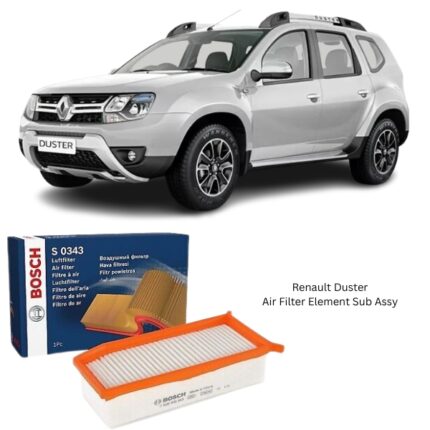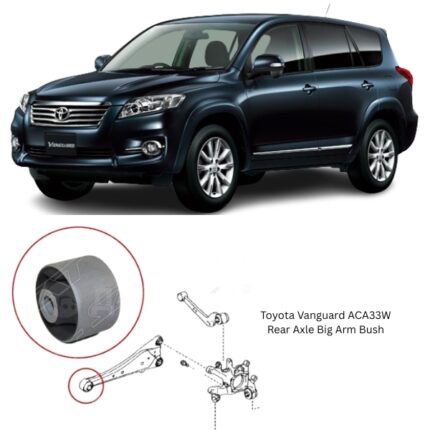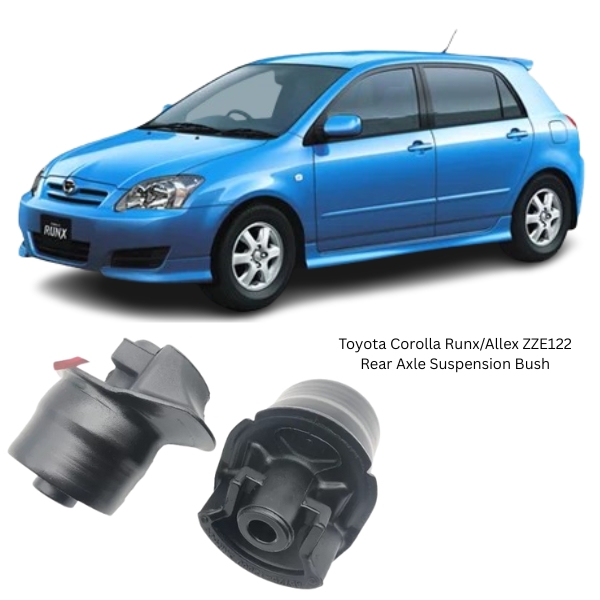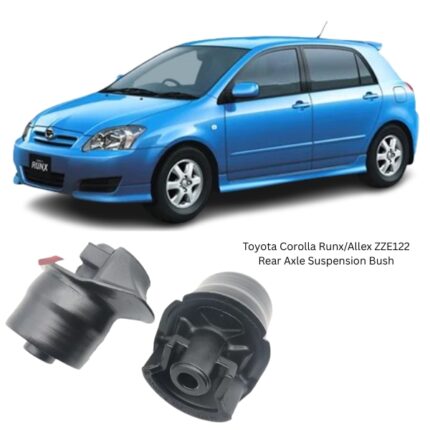Get Toyota Corolla Runx/Allex ZZE122 Rear Axle Suspension Bush 48725-12560 in Kenya
The Rear Axle Suspension Bush is a crucial component in a vehicle’s suspension system, designed to provide a flexible yet secure connection between the rear axle and the chassis or suspension arms. Although small and often overlooked, this rubber-based part plays an essential role in absorbing road shocks, controlling axle movement, and reducing vibrations that would otherwise be transferred to the vehicle body.
Bushes serve as cushioning joints that replace rigid metal-on-metal connections with elastomer-based dampening. The rear axle suspension bush is specifically located at the rear axle beam or trailing arm area and is engineered to maintain proper rear-wheel alignment and axle articulation under dynamic driving conditions.
Primary Function and Purpose
The main role of a rear axle suspension bush is to provide flexible support and vibration isolation between the axle and the frame. It enables limited movement while resisting the twisting, bending, and side loads imposed by cornering, braking, and uneven road surfaces.
Key functions include:
-
Vibration Dampening
The bush reduces road noise and impact by absorbing shocks and vibrations from the axle before they reach the chassis or cabin. -
Axle Alignment Stability
It ensures that the rear axle remains properly aligned, supporting consistent wheel geometry for safe handling. -
Control of Axle Movement
Allows a controlled amount of lateral, vertical, and rotational movement to accommodate suspension travel while maintaining structural integrity. -
Chassis and Suspension Protection
By acting as a cushion, the bush reduces wear and fatigue on other components such as the axle beam, control arms, and subframe. -
Comfort and Handling
Helps strike a balance between ride comfort and road handling, reducing harshness without compromising vehicle control. -
Noise Reduction
Minimizes the transmission of road noise into the passenger compartment, improving the overall driving experience.
Together, these roles make the rear axle suspension bush integral to both the performance and longevity of the suspension system.
Design and Construction
The rear axle bush is typically a cylindrical or oval-shaped component constructed from a blend of rubber or polyurethane bonded to a metal inner sleeve. The specific design may vary depending on its exact location and function within the suspension layout.
Components:
-
Outer Shell
Made from steel or aluminum, the outer shell provides rigidity and mounts into the axle housing or suspension arm. -
Elastomer Core
The main vibration-dampening material, typically made from natural or synthetic rubber or polyurethane. The elastomer absorbs vibration and allows movement within designed tolerances. -
Inner Sleeve
A steel sleeve inserted through the center of the bush where the mounting bolt passes. This inner tube ensures the bush stays securely fastened and acts as the load-bearing core during movement. -
Void Design
Many bushings feature strategic voids or cavities molded into the rubber, which control flexibility in specific directions and fine-tune the ride characteristics. -
Bonding Agent
A high-strength adhesive is used to permanently bond the rubber to the inner and outer metal components, ensuring durability under dynamic stress.
The bush is typically pressed or bolted into place and engineered to withstand thousands of suspension cycles without deformation or failure.
Performance Characteristics
The Rear Axle Suspension Bush is designed to perform reliably under a variety of road and load conditions. Its performance characteristics include:
-
Load-Bearing Support
Capable of absorbing and distributing static vehicle weight and dynamic loads during acceleration, braking, and cornering. -
Vibration Isolation
Reduces both low- and high-frequency vibrations from road imperfections and mechanical components. -
Durability Under Stress
Withstands heat, cold, torsional loads, and chemical exposure (such as oil, fuel, and road salt) without cracking or deteriorating prematurely. -
Flexibility and Stiffness Balance
Engineered to offer enough compliance for comfort while being stiff enough to maintain alignment and control. -
Thermal and Environmental Resistance
Maintains integrity across a wide temperature range and in various driving environments, from urban streets to rugged off-road paths.
These features contribute to both driver comfort and vehicle handling precision.
Symptoms of a Worn Rear Axle Suspension Bush
Over time, the bush can degrade due to exposure to harsh conditions and repetitive motion. Common symptoms of a worn or failing rear axle bush include:
-
Clunking or Knocking Sounds
Loose movement between the axle and chassis can cause metal-on-metal contact, resulting in noises during driving over bumps or while turning. -
Excessive Rear-End Vibration
A deteriorated bush fails to dampen vibrations, leading to noticeable shaking in the rear of the vehicle. -
Poor Handling or Instability
Rear-end sway, especially during cornering or braking, may indicate a loss of bush stiffness or control. -
Uneven Tire Wear
Misalignment of the rear axle due to bush deterioration can cause abnormal or premature tire wear. -
Visual Inspection Signs
Cracked, torn, or collapsed rubber, or a loose fit within the axle housing, clearly indicates a bush that needs replacing. -
Noise During Gear Changes
In vehicles where the bush also supports driveline forces, you may hear thuds or clunks when shifting gears.
Prompt replacement of worn bushes prevents further damage to the suspension and driveline components.
Installation Overview
Replacing the Rear Axle Suspension Bush requires mechanical skill and specialized tools, particularly if the bush is press-fitted into the axle beam.
General Steps:
-
Safety and Support
Lift and securely support the vehicle on a hoist or jack stands. Remove rear wheels if needed for access. -
Access and Disassembly
Depending on the location, you may need to remove the axle beam or trailing arms to access the bush. -
Old Bush Removal
Press or cut out the old bushing using a hydraulic press or bush removal tool. Take care not to damage the mounting area. -
New Bush Installation
Lubricate and press the new bush into place, ensuring it is seated correctly and aligned with any orientation marks. -
Reassembly
Reinstall any removed suspension components and torque all bolts to manufacturer specifications. -
Alignment Check
After installation, have the rear suspension alignment checked and adjusted as needed.
Professional installation is recommended for pressed-in or bonded bushings due to the tools and precision required.
Maintenance and Replacement Recommendations
While suspension bushes are not part of routine service schedules, regular visual inspections during oil changes or suspension work can catch early signs of wear.
Replacement intervals vary by:
-
Driving Conditions: Frequent rough roads or heavy loads accelerate wear.
-
Mileage: Typically, bushes last between 60,000 to 120,000 km, though this can vary.
-
Vehicle Age: Rubber can degrade over time even if mileage is low.
Upgrading to polyurethane bushings can offer longer life and better performance but may slightly increase ride harshness.
Benefits of Replacing Rear Suspension Bushes
-
Improved Ride Comfort: Restores smoothness and reduces cabin vibrations.
-
Better Handling and Control: Keeps the axle aligned under load for consistent road behavior.
-
Reduced Component Wear: Prevents further stress on tires, springs, shocks, and control arms.
-
Safer Driving: Enhances rear-end stability during braking, cornering, or when towing.
-
Quieter Ride: Eliminates thuds, creaks, and knocks associated with loose suspension joints.
Follow us on Facebook for more parts.





Reviews
Clear filtersThere are no reviews yet.